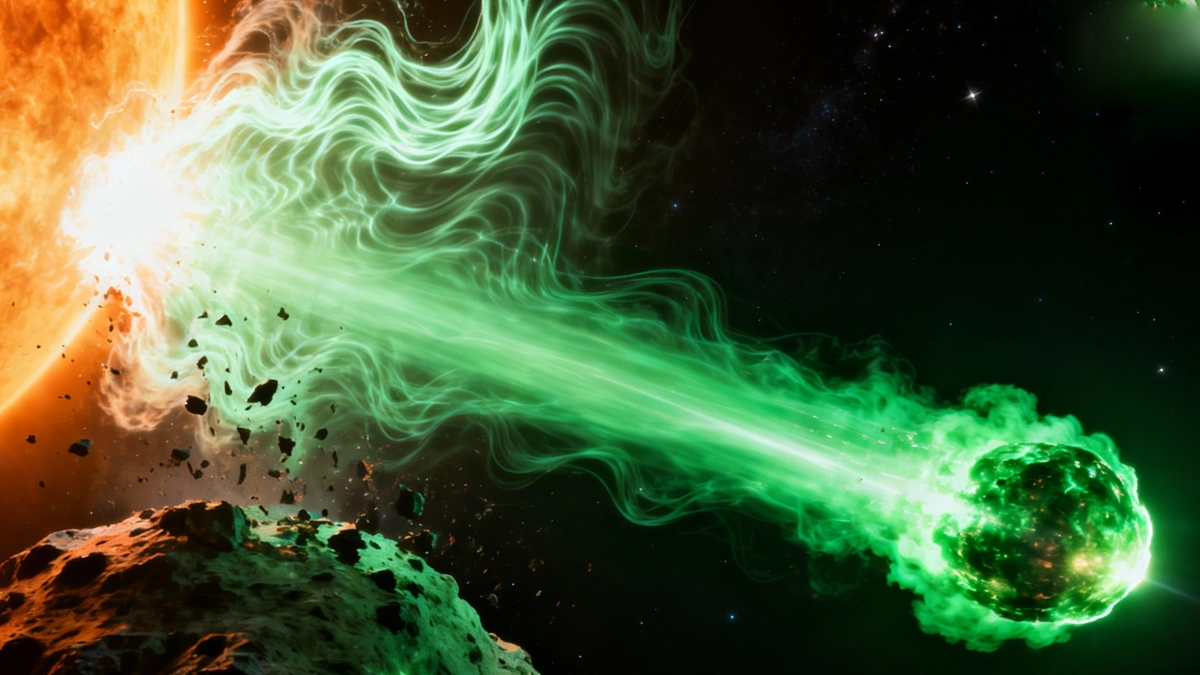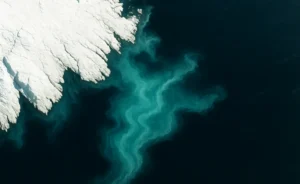A fiery wave from the Sun can rip a comet’s tail clean off—an eerie spectacle we’ve witnessed before—but this time the target is an interstellar visitor, turning a familiar space-weather drama into a once-in-a-generation scientific opportunity that traces directly back to decades of comet–storm forensics and the dawn of interstellar object hunting.
How comets became space-weather gauges
Long before interstellar visitors were on astronomers’ radar, comets served as makeshift sensors for the solar wind and coronal mass ejections, with their long, delicate ion tails “kinking” or disconnecting when slammed by fast-moving solar plasma. The physics is simple and brutal: the ion tail is magnetically tethered to the heliospheric field; when a CME with a different magnetic configuration sweeps past, field lines snap and reconfigure, severing the tail in a transient “disconnection event.” In practical terms, a comet’s tail is like a windsock: it points, wiggles, and sometimes tears—revealing the invisible gusts and shocks of the Sun’s changing breath.
The first solid clues: kinks, scallops, and vanishing tails
In the early 2000s, researchers stitched together spacecraft imagery and ground-based photos to show CMEs could dramatically distort or erase a comet’s ion tail for minutes to hours. Those observations shifted comets from mere curiosities to dynamic tracers of solar storms between the Sun and the planets. The lesson: a violent solar outburst didn’t just flare and fade near the Sun—it propagated outward, reshaping ephemeral structures across astronomical units.
The STEREO era: catching the act on camera
With heliophysics sentinels watching continuously, modern disconnection events became cinematic: a greenish fuzz sails through a coronagraph’s field and a sudden plasma front pinches off its tail. These sequences confirmed the mechanism and timing—storm hits, tail detaches, a fresh tail grows as the nucleus continues outgassing. Over the last decade, multiple comets have been “body-checked” this way, and each event provided tighter constraints on shock speeds, magnetic polarity flips, and how fast the tail regrows under sustained solar wind.
Enter the interstellar age: 1I, 2I, and a new kind of target
The discovery of 1I/‘Oumuamua in 2017 and 2I/Borisov in 2019 opened an entirely new chapter: not all visitors are ours. Interstellar objects carry different compositions, textures, porosities, and volatile mixes—formed under alien stellar histories. Observing their behavior under our Sun’s weather isn’t just curiosity; it’s comparative planetology at interstellar scale. An interstellar comet’s coma chemistry and dust-to-gas balance can respond differently to solar radiation and wind, encoding clues about its birthplace.
Why a solar storm striking an interstellar comet matters now
- A composition stress test: Disconnection events probe ion chemistry and dust coupling; an interstellar comet under CME impact may display distinct ion species ratios, tail brightness profiles, or regrowth timelines that hint at unfamiliar volatile inventories.
- Heliosphere boundary context: During a solar maximum upswing, storm frequency and intensity rise; catching an interstellar target mid-surge helps benchmark how “universal” tail disconnections are across differing nucleus properties.
- Modeling payoffs: MHD models can be tuned using real-time tail morphology changes—kink formation, pinch-off length scales, and regrowth rates—to refine CME density, speed, and magnetic topology estimates along the comet’s path.
- A natural laboratory for pickup ions: Freshly created ions from alien volatiles get swept into the solar wind; their signatures, if detected, help map charge-exchange and pickup processes under transient magnetic structures.
What the science teams will look for
- Morphology timeline: High-cadence imaging before, during, and after the CME arrival to map the exact moment of magnetic disconnection and the geometry of the severed tail segment.
- Spectral fingerprints: Narrowband imaging or spectroscopy to track ion species (e.g., CO+, N2+, CN) and any unusual emissions that might deviate from typical long-period comet behavior.
- Polarimetry and dust phase functions: If dust scattering changes across the event, it can constrain dust size distributions and whether dust tails couple differently than ion tails under shock compression.
- Regrowth kinetics: The rate at which the tail reforms as the coma replenishes ions provides constraints on outgassing rates and the ionization environment, potentially revealing composition contrasts with native comets.
Constraints, caveats, and what-if scenarios
- Geometry rules all: If the CME’s magnetic field orientation aligns in certain ways with the comet’s induced magnetotail, disconnection can be dramatic; if not, the event may look muted, offering a useful non-detection that still constrains field configuration.
- Distance dampens drama: Farther from the Sun, both solar wind density and photoionization rates fall, potentially elongating timescales and reducing brightness contrasts—data reduction will lean heavily on stacking and background subtraction.
- Composition surprise: If the interstellar comet is unusually rich in molecules that ionize or fluoresce at atypical rates, standard filters may underperform; adaptive observing plans with broader spectral coverage will be key.
- Secondary effects: A strong shock can spawn filamentary structures and detached “blobs” that drift downwind; tracking these parcels over days refines solar-wind flow and turbulence parameters.
The bigger ecosystem: from space weather to star weather
This event sits at the crossroads of cometary science, heliophysics, and interstellar archaeology. It turns a single solar outburst into a cross-disciplinary experiment, linking CME magnetism, ion-tail microphysics, and a sample of material forged around another star. If similar disconnections are documented for future interstellar comets, scientists can begin to compare space-weather responses across a spectrum of alien chemistries—an emergent “star weather on loan” program, where our Sun provides the forcing and the visitor provides the clues.
What success looks like
- A time-resolved sequence capturing the pinch-off and the first hours of tail regrowth.
- Multi-instrument coverage (imaging, spectroscopy, possibly radio for pickup-ion effects) that ties morphology to composition.
- MHD model fits that reproduce the tail evolution only when the CME’s field polarity and speed match solar-imaging inferences—closing the loop between coronal source and deep-space consequence.
- A composition-informed narrative that slots the interstellar comet’s behavior alongside historic native-comet disconnections, highlighting both common physics and unique chemistry.
Why this will be remembered
Comet tails have long acted as the universe’s smoke trails—ephemeral, beautiful, but diagnostically rich. When the Sun’s storm meets a comet from another star, it upgrades a striking sky show into a data-rich milestone, revealing how universal plasma physics meets local chemistry on a stage big enough to connect two stellar neighborhoods. In a decade, this may be cited as the moment interstellar comet science evolved from discovery to diagnosis, with the Sun’s temper providing the stress test that theory alone could not.
Last Updated on October 18, 2025 by Lucy




